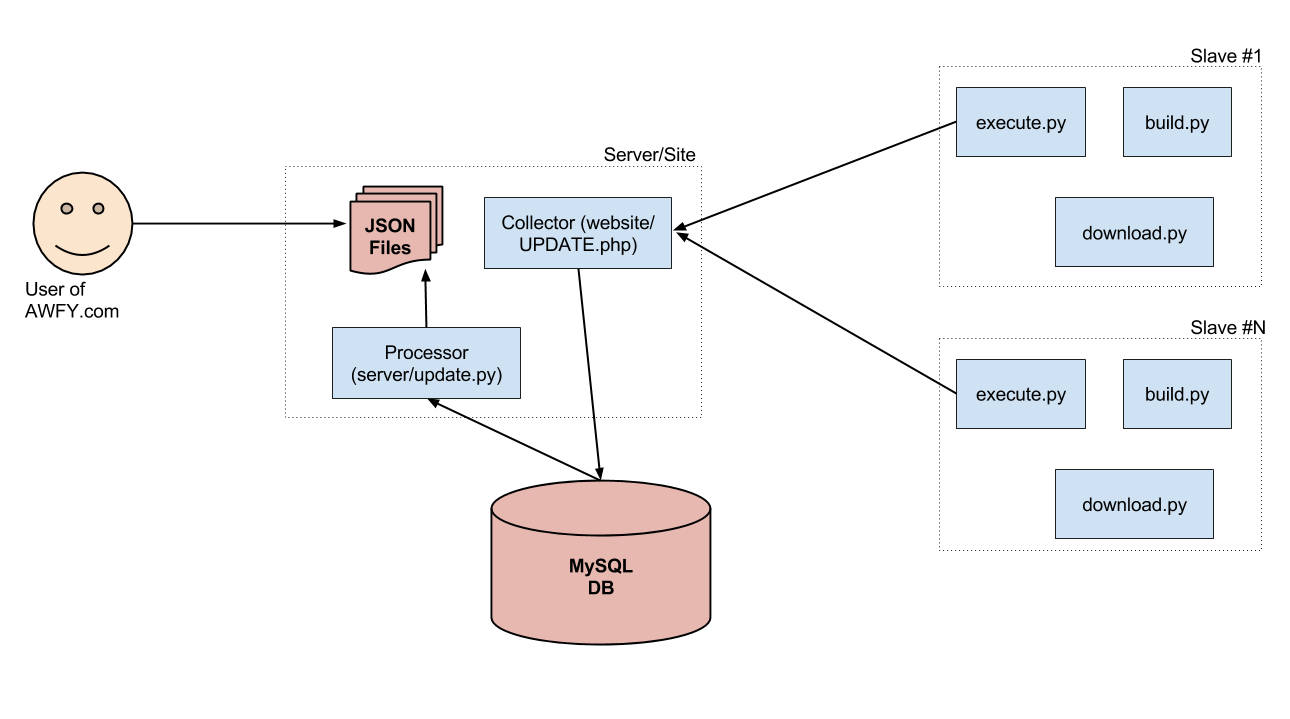|
|
||
|---|---|---|
| benchmarks | ||
| database | ||
| detector | ||
| docs | ||
| server | ||
| slave | ||
| website | ||
| .gitignore | ||
| LICENSE | ||
| README.md | ||
README.md
Components
Slave:
- Builder: A python driver (build.py) that can create shell builds of spidermonkey/jsc/v8.
- Downloader: A python driver (download.py) that can download browser builds of Firefox.
- Executor: (execute.py) is a python script that executes one or multiple benchmarks on one or more builds.
Site:
- Database: MySQL database that stores statistics.
- Collector: Hidden PHP script on the webserver, where stats get sent. (UPDATE.php in below diagram)
- Processor: Python aggregator that builds JSON data from the DB. (update.py in below diagram)
- Website: Static HTML as the frontpage, that queries JSON via XHR.
- Command center: Sends commands to the slaves on what to execute. (In construction.)
Components (2) and (4) must be on the same webserver, otherwise timestamps might not be computed correctly.
Keep in mind, most of this documentation is for posterity. AWFY was never intended to be a drag-and-drop all-in-one released product, so the procedures and scripts may be pretty rough.
System Diagram
Benchmark locally
- Fetch the repo
- Create a (shell) or retrieve a (browser) build to benchmark
-
Creating a build:
cd slave python build.py -s mozilla -
Pull a build:
cd slave python download.py http://archive.mozilla.org/pub/mozilla.org/firefox/tinderbox-builds/mozilla-inbound-linux/latest/
-
Benchmark
python execute.p -b remote.octane -b remote.kraken
Installation
Database
Create a database and import/run database/schema.sql.
Data Collector
Drop website/UPDATE.PHP and website/internals.php somewhere, and rename UPDATE.PHP to something secret. Make sure you don't have directory listings enabled.
Slave DNS Config
Before running the benchmarks, add these lines to your /etc/hosts file and flush DNS cache. These host addresses are used by benchmarks_remote.py. This configuration is needed for all the slaves that use the remote or local benchmarks. Only the shell benchmarks don't need it.
# Subdomains for AWFY
127.0.0.1 dromaeo.localhost
127.0.0.1 kraken.localhost
127.0.0.1 octane.localhost
127.0.0.1 massive.localhost
127.0.0.1 jetstream.localhost
127.0.0.1 speedometer.localhost
127.0.0.1 speedometer.localhost
127.0.0.1 sunspider.localhost
127.0.0.1 browsermark.local
Benchmark Computers
In development...
Data Processor
Put awfy-server.config in /etc, and edit it to point at your database and website/data folder. Then put update.py in a cronjob. It will dump files where appropriate. AWFY.com does this every 15min. It is not safe to run two instance at once. A sample wrapper script is provided as run-update.sh.
update.py generates various JSON files:
- "raw" and "metadata" files cache database queries from run to run, so we don't have to make expensive database queries.
- "aggregate" files are used for the front page.
- "condensed" files are used for one level of zooming, so users don't have to download the raw data set right away.
The metadata and raw JSON files are updated as needed. The aggregate and condensed files are always re-generated from the raw data.
There is also a monitor.py script provided in the server folder. You can run this regularly to send e-mails for benchmarking machines that haven't sent results in a certain amount of time (this time is specified in awfy-server.config). It will send e-mail through the local SMTP server, using the "contact" field for each machine in the database. This field should be a comma-delimited list of e-mail addresses (i.e. "egg@yam.com,bob@egg.com").
Website
Put the files somewhere. Currently php is needed for data.php, which pulls the data from the correct location. You just need to update config file (/etc/awfy-server.config) to refer the 'data' folder that contains the json/js files dumped by update.py.
Don't forget to replace the default machine number in website/awfy.js, which is the one that will show up in the first place. Note that AWFY's flot is slightly modified, so it might not work to just replace it with upstream flot.
